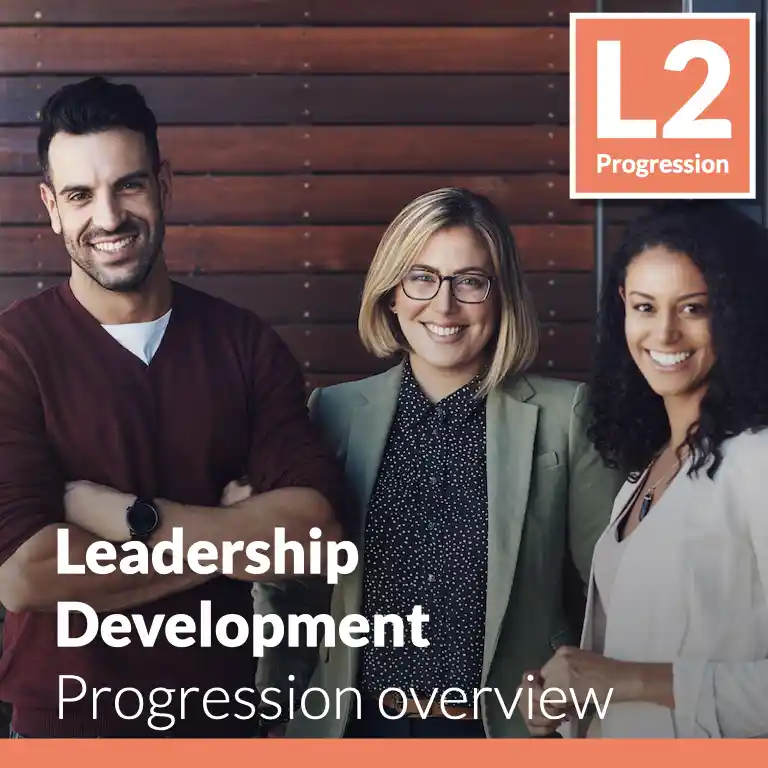Enjoy instant access to a scalable system of proven practices and execution-ready tools. Built to launch strategic HR programs 5X faster!
✓ Enjoy platform access
✓ Create your HR roadmap
✓ View open content in library
✓ Access dozens of practices:
⤷ The HR Strategy program
⤷ Explainers and deep dives
⤷ Supplemental guides
⤷ Insight articles
⤷ Weekly best practices
⤷ And more!
100% Free. No credit card required.
This guide is part of a progression set comprised of Core, Advanced, and Emerging Leadership Development practices.
Leadership Development (LD) is a business strategy-aligned approach structured around an idealized vision of how leaders will conduct themselves and the business. It is driven by a defined view of what a company’s leadership looks like, how it behaves, drives performance, and supports the corporate vision, mission, and strategies. It defines how leaders will be viewed and experienced by their employees and what behaviors will be reinforced and rewarded.
The development programming at this level includes formal assessments of leaders’ traits, capabilities, styles, and skillsets, as well as how those are used to define professional and personal learning and development requirements on an individual basis and drive performance as a manager or leader. A formal process of identifying future leaders is created, with relevant criteria and standards that can be used to evaluate candidates from across the organization and its functions, locations., and business units. Development is offered to leaders across levels – from executives down to supervisors – through programming tailored to each leader level. This drives the growth of individuals in a consistently managed and reinforced manner throughout their leadership career journeys.
Leadership Development creates a cadre of business leaders at all levels who act in greater synch with corporate objectives and goals, allowing them to achieve business goals by leveraging management skill and capability gains to drive improved operational and business efficiencies and effectiveness. Their strategizing, planning, thinking, and actions are better aligned with corporate strategies as they evolve through the years. It creates a formal and more objective process for early identification of future leaders who can then become exposed to learning and development opportunities aligned with well-documented standards of leadership expertise. Through participation in sequenced (by career level) development programs, leaders build more robust internal networks for enhanced problem-solving, collaboration, and alignment of work efforts.
It also enables greater alignment with espoused corporate virtues and values, creating a more consistent experience for employees as they progress throughout their careers. Such an experience can drive employee engagement and retention improvements, motivation to exceed performance standards, and meeting functional and corporate goals and objectives. It can also increase the satisfaction and retention of the leaders themselves with specialized development opportunities and the opportunity to experience an increased sense of success as a leader.
By adopting these practices, an organization can expect a well-developed alignment between the development strategy and business objectives. This linkage helps drive credibility, buy-in, and acceptance of the associated plans and programs from all leaders across the enterprise. It validates the competency model with direct linkages to specific business directions, strengthening the ties between the business needs and the development plan elements. It articulates a leadership vision describing the most important or highest-priority traits and behaviors the ideal leader exhibits. A formal leadership strategy is generated from these practices that define the “who,” “what,” and how” of the plans that provide the ability to build a roadmap and budget for their skill building. A leadership brand is articulated that clarifies how the organization wants its leaders to be described, and a set of integrations is created with other processes to ensure that it is being developed and upheld by existing and new leaders.
Formal assessments are identified, developed, and tested as more objective and bias-free (or -reduced) methods for evaluating current and future leaders. With those, more targeted development of identified strengths, weaknesses, and specific skills/attributes/capabilities can be identified for each individual. A critical outcome of deploying these practices involves broadening the leadership aperture to include future leaders or high potentials (HiPos). This leads to an enhanced competency model that lists level-specific capabilities of leaders at lower, non-executive levels (e.g., supervisor, manager, director, etc.) and can be used to define learning requirements appropriate to their operating level. Once the criteria are established, identification, evaluation, and selection are created and formalized. A formal development process/program is then created for offering to identified HiPos.
Building a direct linkage, or flow-down, from corporate strategic plans into goals and targets to be achieved by the leadership development program.
A plan for how leaders will be used to drive company objectives and goals, defining the leaders, describing their traits, how they should act and treat others, and what they should focus on.
Incorporating formal assessments that heighten objectivity to leadership development efforts, reducing bias from purely opinion- and observation-based assessments of strengths, fit and competencies.
Building future executives earlier in their careers as supervisors or managers so that their ability to lead increasingly large, multi-leveled, geographically dispersed, and functionally complex organizations develop gradually and effectively over time.

Enjoy instant access to a scalable system of proven practices and execution-ready tools. Built to launch strategic HR programs 5X faster!